Mastering the MACD indicator involves understanding its components: MACD line, signal line, and histogram. Calculating MACD signals through EMA differentials aids in identifying market trends. Interpreting the MACD histogram provides insights into momentum strength and trend changes. Timing entry and exit points based on MACD crossovers and RSI levels can optimize trades effectively. Integrating MACD with RSI and Bollinger Bands enhances market analysis for accurate decision-making. Implementing risk management techniques and maximizing trading potential through strategic use of indicators guarantees better outcomes. Explore advanced MACD strategies for further trade optimization insights.
Understanding MACD Components
In the domain of technical analysis for trade optimization, a fundamental aspect lies in comprehending the intricate components of the MACD indicator. The MACD components, including the MACD line, signal line, and histogram, play an essential role in analyzing market momentum and trend direction.
The MACD line is derived by subtracting the 26-period Exponential Moving Average (EMA) from the 12-period EMA, offering insights into the strength of a trend. Meanwhile, the signal line, represented by a 9-period EMA of the MACD line, provides trading signals by crossing above or below the MACD line, indicating potential buy or sell opportunities.
Additionally, the histogram, which illustrates the variance between the MACD line and the signal line, aids traders in identifying shifts in market momentum. Understanding these MACD components equips traders with the necessary tools to anticipate market reversals and make informed decisions when optimizing trades.
Calculating MACD Signals
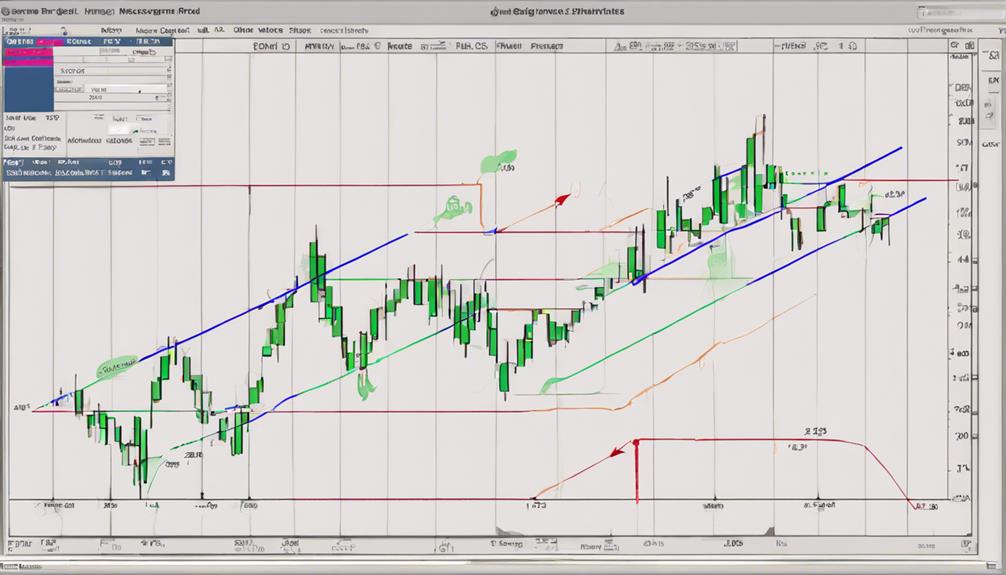
How can traders effectively calculate MACD signals to enhance their trade optimization strategies?
MACD signals are determined by subtracting the 26-period Exponential Moving Average (EMA) from the 12-period EMA. This calculation forms the MACD line, an essential indicator of market momentum and trend direction.
Additionally, a signal line is created by computing a 9-period EMA of the MACD line. The interaction between the MACD line and the signal line provides insights into potential buy or sell signals, aiding traders in decision-making.
Understanding the nuances of calculating MACD signals is pivotal as it offers a glimpse into market trends and potential shifts in momentum. By tracking the crossovers between the MACD line and the signal line, traders can anticipate changes in market sentiment and optimize their trading strategies accordingly.
Mastering the calculation of MACD signals empowers traders to interpret market dynamics more effectively, thereby improving their overall trading performance.
Interpreting MACD Histogram
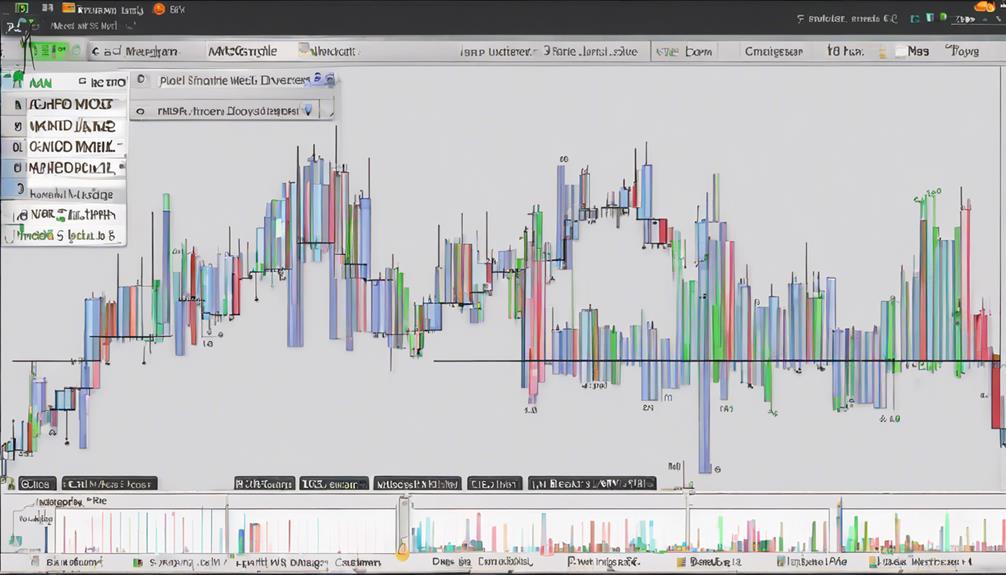
The MACD histogram serves as an essential tool for traders to gauge trend changes. Its bars indicate the strength and direction of momentum. Positive histogram values above zero signal bullish momentum, while negative values below zero denote bearish momentum.
Traders closely watch for convergence and divergence between the histogram and price action to anticipate potential shifts in market trends.
Histogram Signals Trend Changes
When interpreting the MACD histogram, traders can leverage the visual representation of the difference between the MACD line and the signal line to gauge momentum shifts in market trends.
The histogram's bars reflect the momentum of the market trend, with increasing bars indicating a strengthening momentum and potential continuation of the trend. Conversely, shrinking bars suggest a possible slowdown in momentum, signaling a potential trend reversal or consolidation.
By closely monitoring the changes in the histogram, traders can anticipate trend shifts and make well-informed trading decisions.
Combining the analysis of the MACD histogram with other components of the MACD indicator offers a thorough understanding of the market dynamics, enhancing the effectiveness of trading strategies.
Positive Vs Negative Values
When analyzing the MACD histogram, traders can discern market dynamics by interpreting the positive and negative values. These values offer valuable insights into bullish and bearish momentum for strategic trading decisions.
Positive histogram values indicate bullish momentum, signaling potential buying opportunities as the asset's price is likely to increase. Conversely, negative histogram values suggest bearish momentum, indicating potential selling opportunities as the price is expected to decrease.
The histogram represents the difference between the MACD line and the signal line, allowing traders to visually assess the strength of market movements. By monitoring the size of histogram bars – increasing bars for strong momentum and decreasing bars for weakening momentum – traders can better gauge the speed and strength of price movements. This aids in making informed trading decisions.
Convergence and Divergence
Interpreting the MACD histogram through convergence and divergence patterns provides traders with critical insights into market momentum shifts and potential trading opportunities. The MACD histogram measures the variance between the MACD line and the signal line, offering a visual representation of momentum strength. Increasing histogram bars indicate robust market movements, while decreasing bars suggest a potential slowdown in momentum.
Traders analyze histogram patterns to anticipate trend changes and validate trade entries or exits. Divergence within the histogram can signify shifts in momentum, presenting possible trading opportunities. Understanding how to interpret MACD signals, especially through the histogram, is essential for making informed trade decisions and maximizing profitability in the financial markets.
Timing Entry and Exit Points
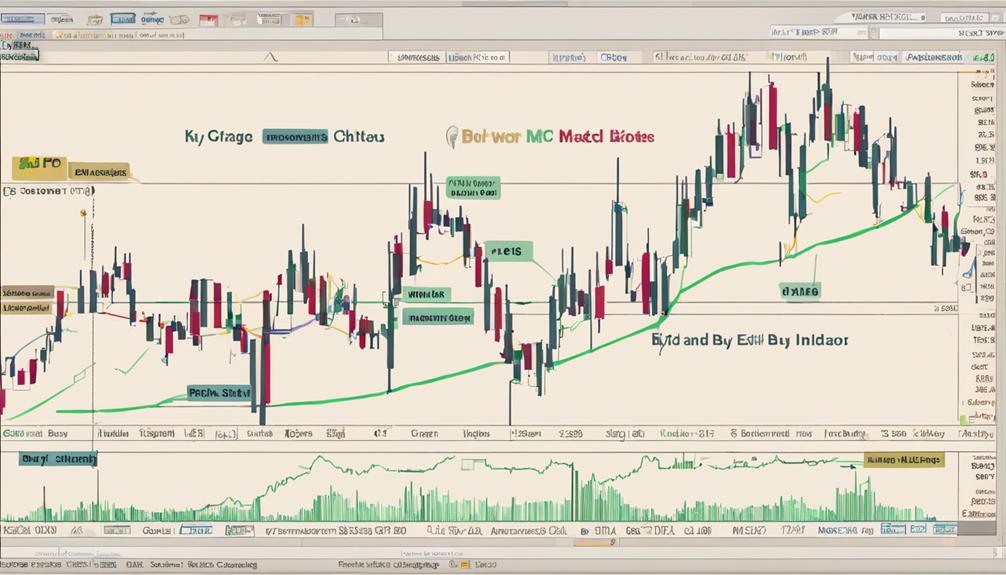
When optimizing trade entries and exits using MACD, it is essential to focus on entry signal confirmation and exit strategy implementation.
Entry points can be identified through MACD crossovers and histogram reversals, while zero line crosses on the histogram can help confirm trend directions for efficient exit strategies.
Entry Signal Confirmation
For ideal trade execution, confirming entry signals through the MACD line crossing above the signal line for buys or below for sells is crucial. By waiting for this validation, traders can increase the likelihood of entering a position at a favorable time. Additionally, considering the direction and size of histogram bars can provide further momentum confirmation for trade decisions. The table below summarizes the key points for entry signal confirmation using MACD:
| Aspect | Description |
|---|---|
| MACD Line Crossing | Wait for the MACD line to cross above the signal line for buy signals and below for sell signals. |
| Histogram Bars | Analyze the direction and size of histogram bars for momentum confirmation. |
| Signal Line Confirmation | Make sure the signal line confirms the direction indicated by the MACD line. |
Exit Strategy Implementation
Implementing MACD histogram reversals can greatly enhance the effectiveness of timing entry and exit points in trading strategies. By utilizing MACD crossovers in conjunction with price action confirmation, traders can execute precise exit strategies.
Zero line crosses on the MACD indicator serve as valuable indicators for confirming ideal exit points in trending markets. Incorporating trailing stop-loss orders based on MACD signals can help secure profits and minimize losses effectively.
Additionally, recognizing MACD divergence patterns aids in identifying potential exit points before trend reversals occur, providing traders with an edge in their decision-making process.
Applying MACD Trading Strategies
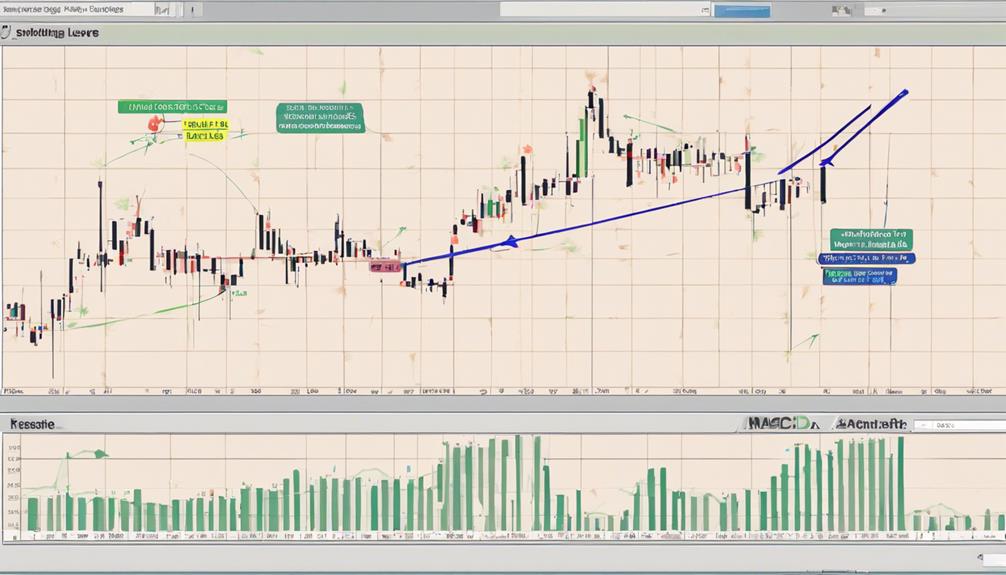
Utilizing MACD trading strategies involves a detailed analysis of crossover patterns between the MACD line and signal line to identify potential buy or sell signals. This analysis helps traders determine entry and exit points with more precision, important for maximizing profits and minimizing losses. By understanding the implications of MACD histogram changes, traders can gauge market momentum and strength, aiding in decision-making processes.
For day traders, pinpointing entry and exit points using MACD signals is vital for capitalizing on short-term price movements. Backtesting these strategies with historical data can refine approaches and improve overall trading decisions. Additionally, combining MACD with other indicators such as Relative Strength Index (RSI) or Bollinger Bands enhances the accuracy of market analysis and provides additional confirmation for potential trades. This integration of multiple indicators offers a more thorough view of the market, increasing the likelihood of successful trades based on well-rounded analysis.
Confirming Market Trends
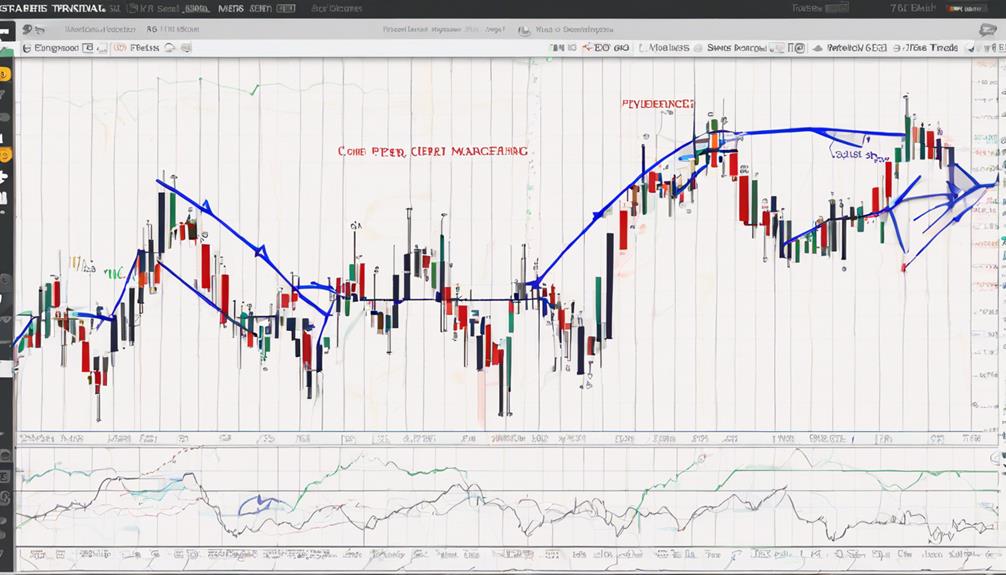
When analyzing market trends with MACD, traders rely on the relationship between the 12-period and 26-period EMAs to confirm the direction of the trend through crossovers and divergence. By observing the crossovers between these two EMAs, traders can determine whether a trend is bullish or bearish.
A bullish trend is typically confirmed when the 12-period EMA crosses above the 26-period EMA, indicating increasing momentum and potential price appreciation. Conversely, a bearish trend is signaled when the 12-period EMA crosses below the 26-period EMA, suggesting potential price depreciation.
Additionally, divergence between the MACD line and the price chart can also provide insight into potential trend reversals or continuations. The histogram in the MACD indicator complements these crossovers by providing a visual representation of the strength of the trend.
Utilizing MACD for confirming market trends is essential for traders to make well-informed decisions regarding their trade entries and exits based on the prevailing market direction.
Using MACD With RSI
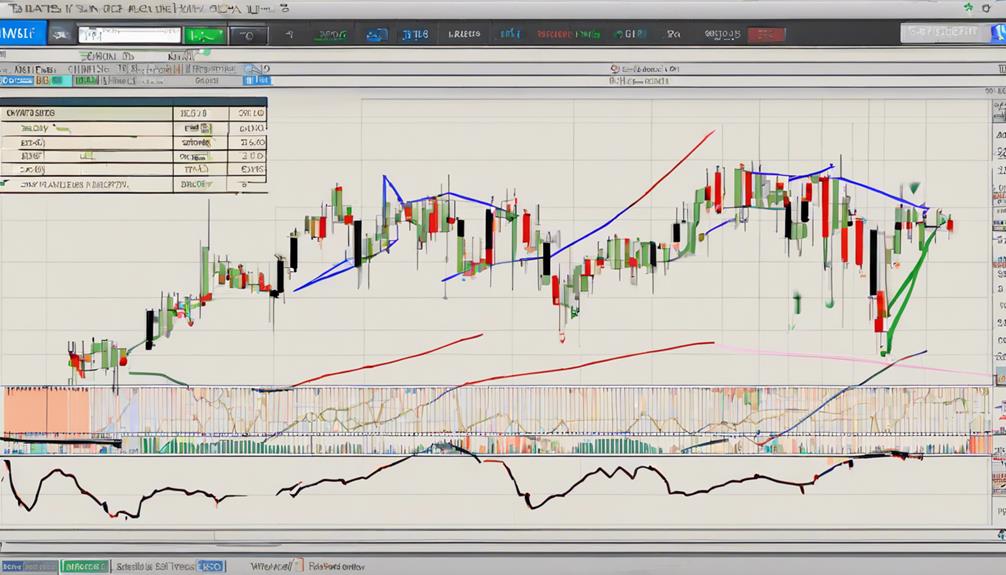
The synergy between MACD and RSI offers traders a thorough view of market dynamics. This allows for more precise timing of trades. By leveraging the benefits of both indicators, traders can confirm trend strength and identify potential reversal points with greater accuracy.
Understanding how MACD and RSI complement each other can greatly enhance trade optimization strategies.
MACD-RSI Synergy Benefits
The integration of MACD with RSI in trading practices yields a harmonious synergy that elevates the accuracy and precision of market analysis. By combining the momentum insights from RSI with the trend-following indications of MACD, traders can enhance their trade confirmations.
RSI's ability to identify overbought or oversold conditions complements MACD's trend confirmation capabilities, providing a holistic view of potential market reversals. This symbiotic relationship between MACD and RSI enables traders to validate momentum shifts within the context of prevailing trends, thus improving the timing of entry and exit points.
When MACD signals align with RSI readings, it strengthens the conviction behind trading decisions, offering a robust foundation for successful trades.
Timing Trades Effectively
Achieving prime trade timing through the strategic utilization of MACD in conjunction with RSI involves a meticulous analysis of alignment in confirmation signals between these two key indicators. When timing trades effectively:
- Look for alignment in MACD crossovers and RSI levels to enhance trade accuracy.
- Utilize MACD crossovers with RSI levels to pinpoint ideal entry and exit points.
- Benefit from MACD's trend-following nature alongside RSI's oscillating behavior for thorough trade analysis.
Confirming Trend Reversals
To effectively confirm trend reversals, integrating MACD with RSI provides traders with valuable additional confirmation signals. RSI, as a momentum oscillator, complements MACD's trend-following capabilities by measuring the speed and change of price movements.
When MACD suggests a potential reversal, RSI can corroborate the signal by indicating overbought or oversold conditions. Waiting for RSI to confirm MACD signals enhances the reliability of identifying trend reversals and determining entry/exit points.
Incorporating Bollinger Bands

When integrating Bollinger Bands with MACD for trade optimization, traders gain a deep understanding of market dynamics and potential entry/exit points. This powerful combination offers a thorough view of market conditions, enhancing trading strategies by providing additional confirmation to MACD analysis. Here's how incorporating Bollinger Bands can benefit traders:
- Assess Market Volatility: By combining Bollinger Bands with MACD, traders can assess market volatility levels, helping them identify periods of heightened price fluctuations.
- Confirm Trend Reversals: Bollinger Bands can assist in confirming trend reversals when used in conjunction with MACD signals, offering traders more confidence in their decision-making process.
- Identify Overextended Price Movements: The upper and lower Bollinger Bands can act as dynamic support and resistance levels, aiding traders in pinpointing overextended price movements and potential reversal points.
Integrating Bollinger Bands with MACD not only helps traders avoid false signals but also provides valuable insights into market trends and price movements.
Implementing Risk Management
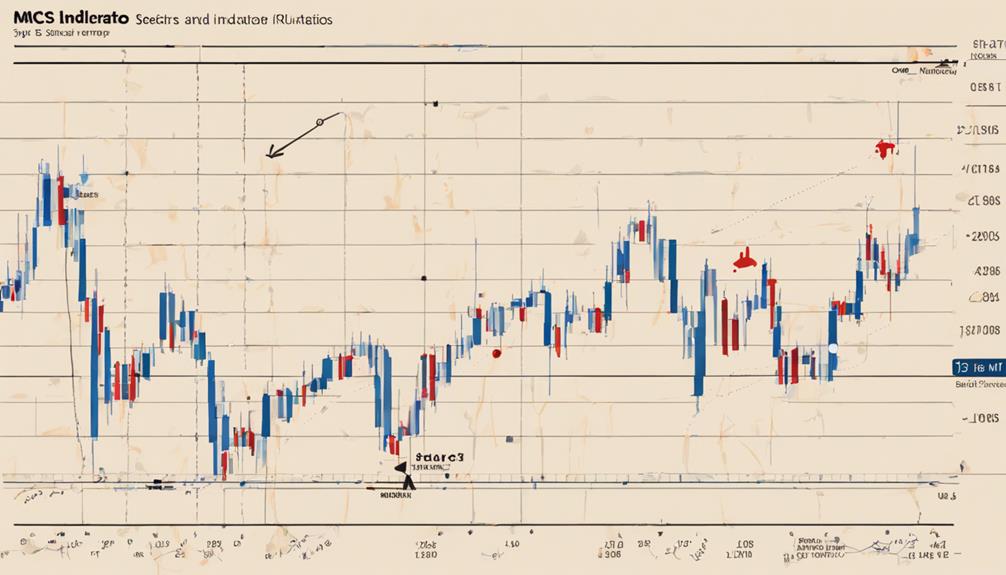
Integrating risk management practices into MACD trading strategies is essential for safeguarding capital and optimizing trade outcomes. When utilizing MACD, setting stop-loss orders is vital to limit potential losses.
Traders can further enhance their risk management by calculating appropriate position sizes based on their risk tolerance and current market conditions. By employing proper risk management techniques with MACD, traders can effectively protect their capital and minimize drawdowns.
Additionally, evaluating volatility levels and adjusting risk parameters accordingly can greatly improve trading effectiveness when using MACD as a tool. Moreover, incorporating risk management practices such as diversification and controlling leverage can lead to better trading outcomes when applying MACD strategies.
Maximizing Trading Potential
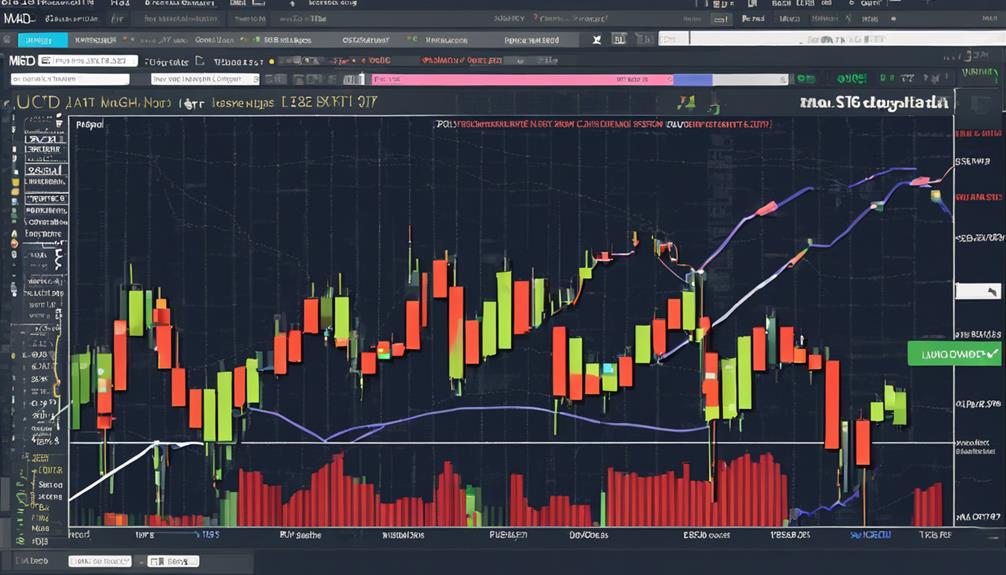
Maximizing trading potential requires a holistic approach that leverages a combination of analytical tools, strategic insights, and a deep understanding of global economic dynamics.
When it comes to implementing MACD strategies effectively, integrating MACD with Bollinger Bands can enhance market volatility analysis and identify overextended price movements.
Additionally, combining MACD with other indicators provides a thorough view for making strategic market entry and exit decisions.
To optimize trading outcomes, incorporating advanced risk management techniques such as dynamic stop-loss orders and position sizing is essential.
By utilizing MACD in conjunction with indicators like the Relative Strength Index (RSI), traders can gain additional confirmation for their strategic trading decisions.
This multi-dimensional approach, encompassing various tools, analysis techniques, and global economic trends, is vital for traders looking to maximize their trading potential and achieve consistent success in the markets.
Frequently Asked Questions
What Is the Best Way to Trade With Macd?
When considering MACD strategies for trading, it is essential to focus on utilizing MACD indicators effectively to analyze market trends.
By paying close attention to MACD signals, traders can identify best entry points based on crossovers between the MACD line and the signal line.
Incorporating MACD into technical analysis provides valuable insights into market momentum and potential price movements, enabling informed decision-making for successful trading outcomes.
What Are the Best Settings for MACD for Day Trading?
When determining the best settings for MACD in day trading, it is crucial to focus on optimizing the signal line.
Interpreting the histogram effectively is also essential.
Incorporating a divergence strategy can further enhance the utility of MACD in day trading.
By fine-tuning parameters such as the fast and slow EMA periods, traders can tailor MACD to capture intraday trends efficiently.
This customization guarantees a more precise indication of market momentum and potential trade entry/exit points, enhancing decision-making in dynamic trading environments.
Do Professional Traders Use Macd?
Professional traders commonly utilize MACD strategies, which leverage MACD signals and indicators to inform their trading decisions. The versatility of MACD allows professionals to identify trends, potential reversals, and ideal trade timing.
What Timeframe Does MACD Work Best On?
Short term analysis with MACD indicators is most effective on intraday strategies, particularly when applied to 15-minute or 30-minute charts for day trading. For swing trading, utilizing MACD signals on 1-hour or 4-hour charts can yield reliable results. Different timeframes such as daily or weekly can also be advantageous for position trading with MACD.
Experimentation with various timeframes is essential for traders to align MACD usage with their trading style and objectives.
Conclusion
In summary, the effective use of MACD in trading requires a deep understanding of its components, signals, and strategies.
By analyzing the MACD histogram, timing entry and exit points, and incorporating other indicators like RSI and Bollinger Bands, traders can optimize their trades and maximize potential profits.
Implementing proper risk management techniques is also essential in ensuring successful trading outcomes.
By mastering the intricacies of MACD, traders can enhance their trading skills and achieve their financial goals with confidence.


